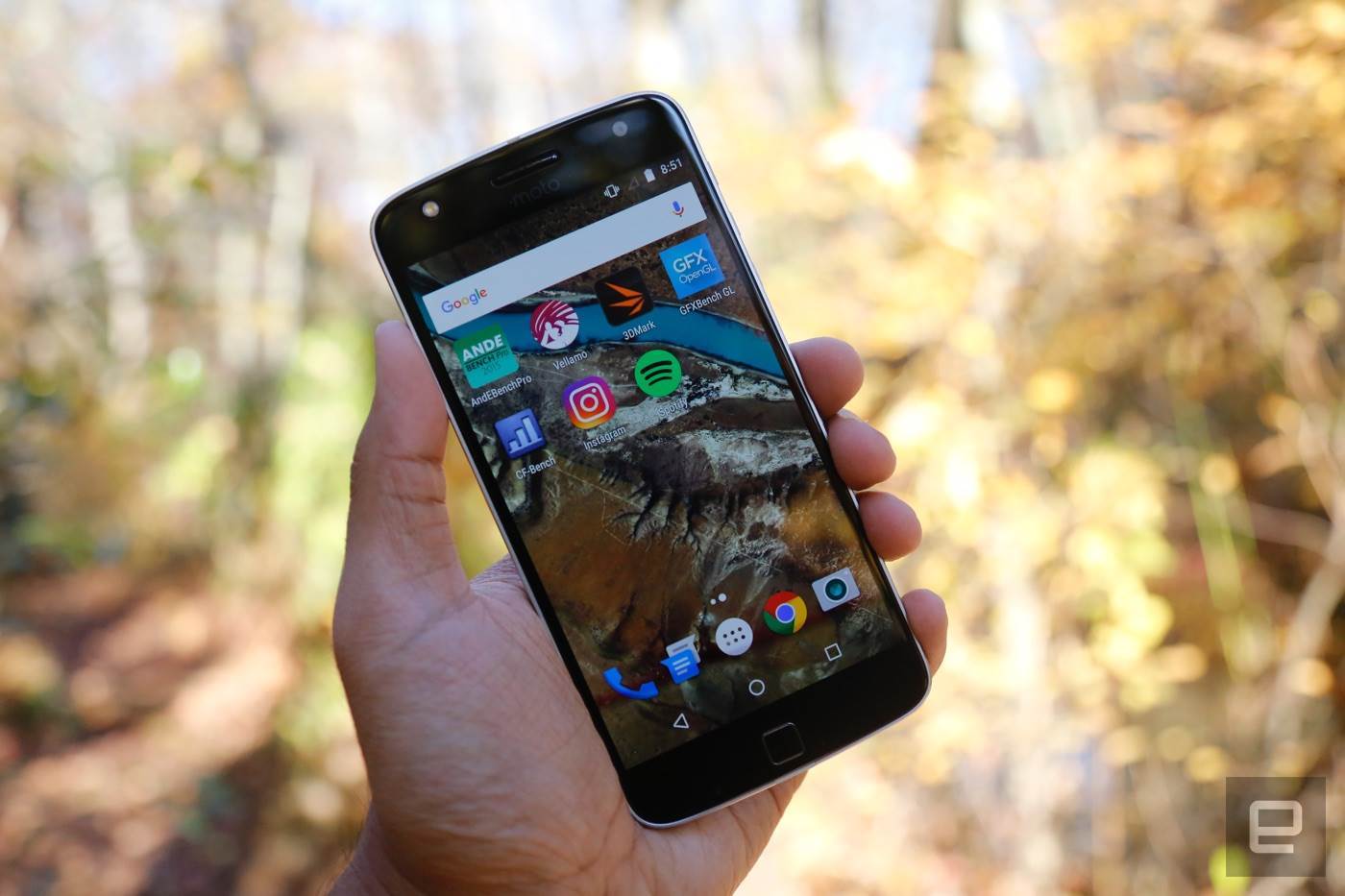You should’ve seen this one coming. Of course Motorola wasn’t going to just release two versions of the Moto Z and call it a year. While the first two — the Moto Z and Moto Z Force — had to bear the weight of flagship expectations and justify the lack of a headphone jack, the Moto Z Play merely had to be inexpensive and not terrible. Well, mission accomplished … mostly. At $449, the Z Play isn’t the cheapest mid-range phone out there, but it clears the “not terrible” bar with more room than I imagined.
All right, all right, there’s no point in being coy. The Moto Z Play is actually pretty great.
Engadget Score
Pros
- Fantastic battery life
- Sturdy build quality
- It has a headphone jack!
- Big screen
Cons
- Not great for gaming
- Rivals have better cameras
- Pricier than competitors
Summary
The Moto Z Play isn’t exactly a steal at $449, but its combination of great build quality, decent performance and excellent battery life make it one of the most exciting mid-range smartphones of the year. It’s still a long way from perfection, though — gamers will lament its lack of extra horsepower, and there are better cameras out there (for less money, even).
Hardware

Let’s get the obvious stuff out of the way: The Moto Z Play looks almost identical to the Moto Z Force, the hardy modular flagship I tested earlier this year. That’s a good thing. From its dimensions to its fingerprint sensor to the signature camera hump around the back, the Moto Z Play looks and feels like a phone that costs almost $300 more.
The phone’s familiar design also means the return of certain annoying design quirks, like the fingerprint sensor that looks, but doesn’t act, like a home button. (I can’t complain about that too much, though, since the sensor actually works very well.) Even stranger, the so-called Moto Mods that magnetically connect to the Z Play’s back don’t feel quite as seamless as when they’re connected to other Moto Z’s. That said, most people probably won’t know the difference.
Gallery: Moto Z Play review (unlocked) | 27 Photos

-

-

-

-
 +23
+23
These kinds of missteps are offset by a general feeling of sturdiness, thanks in large part to the phone’s solid metal rim. My colleague Aaron rightfully gave last year’s Moto X Play some grief because Motorola didn’t pay close attention to the fine details. That’s true here too, but the caliber of construction here still elevates this mid-range phone into more premium territory. While devices like the Moto G series always felt a little chintzy compared with the more premium Moto X line, that sort of quality gap doesn’t really exist here. That doesn’t mean you can treat the Z Play as harshly as you could a Z Force, though — there’s no ShatterShield display, and the Play’s back is made not of metal, but of easily scratched glass.

The differences don’t end there. The Z Play packs a 16-megapixel camera and a 5.5-inch Super AMOLED screen running at 1080p; the regular Z and Z Force both feature Quad HD displays. That dip in screen resolution was inevitable given the Z Play’s price, but who cares — this thing has a headphone jack sitting next to its USB Type-C port. Motorola is still convinced that a single socket for power, audio and everything else is the way of the future, and its bet was vindicated when Apple did the same with the iPhone 7 and 7 Plus. So what gives? Motorola’s rationale is simple: The design of the Z Play’s logic board had room for the port. The mixed message is a little confusing, but hey: No dongles necessary this time.
You wouldn’t know just by looking at it, but the Moto Z Play sits lower on the performance totem pole than either of the Moto Z’s that came before it. There’s an octacore Qualcomm Snapdragon 625 chipset inside, an Adreno 506 GPU and 3GB of RAM, all of which last for a very long time when paired with the Z Play’s 3,510mAh battery.

Remember: The Moto Z Play is modular (as evidenced by the multi-pin connector on its back), so you could strap on a magnetic battery mod for even more battery life. If only Motorola were as generous with the storage options: There’s 32GB of room on board, and only 24GB is available to you from the get-go. At least the micro-SIM tray has a spot for a microSD card with support for up to 2TB of additional space.
This isn’t my first time taking the Moto Z Play for a spin, but this version is different. It’s a fully unlocked GSM model, ready for action on AT&T and T-Mobile in the United States. If you’re a Verizon customer and don’t see yourself switching anytime soon, there’s also a version of the phone just for you — it’s physically identical but packs all of Big Red’s usual bloatware. (More on that later.)
Display and sound

It used to be that buying anything less than a flagship phone meant you got stuck with a lousy screen. Oh, how times have changed. Case in point: The Moto Z Play packs a 5.5-inch AMOLED panel offering respectable viewing angles and great clarity; I never missed the extra resolution on the Moto Z and Z Force. This screen does seem a little dim compared with the Z and Z Force displays, but you’d be hard-pressed to spot the difference when you’re just sitting around inside. Taking the phones outside is a different story, though: The Z Play’s screen is merely passable under bright sunlight, while the Z and Z Force can dial up the brightness quite a bit further. Guess Motorola had to cut corners somewhere.
I’m also fond of how the Z Play renders colors right out of the box: Sunsets and close-ups of wood seem suitably deep, as do the blues and greens that always pop up in landscape photos. If slightly oversaturated colors aren’t your thing, though, you can change things with a trip to the settings (the phone’s display mode is set to “vivid” by default). Toggling the feature to standard mode results in visuals that, while probably a little more accurate, are a lot less fun.

Speaking of things that aren’t much fun, the sound setup here leaves a lot to be desired. Then again, who didn’t see this coming? Motorola used the same lackluster system in the more premium Moto Z and Z Force, with an earpiece that doubles as the main speaker driver when you crank up the volume. Listening to music on a vanilla Z Play is passable at best -– vocals and mids can sound crisp -– and muddled at worst. I wish the Z Play’s speaker was a little louder too, but considering the sort of quality we’re working with, Motorola might have been doing us a kindness by capping the volume.
Thankfully, we have options. First, you can plug in a pair of headphones –- once more, without a dongle! -– and bypass that speaker entirely. Motorola, meanwhile, would much prefer you use that sweet, sweet Moto Mod connector around the back to magnetically lash a completely new set of speakers onto the phone. JBL’s $79 external speaker is the most useful of the multimedia mods available, and while it still focuses on mids and highs, there’s enough heaviness and clarity to its sound that most people I’ve shown it to have enjoyed the experience. You certainly don’t need Moto Mods to use the Z Play, but they are handy.
Software

I’m pleased to report that there isn’t a whole lot to say about the Moto Z Play’s software. Yes, that’s a good thing: It’s fast, familiar and free of the bloatware that comes loaded on the Verizon-branded Z Play. If you’ve used a modern Motorola device, you…







